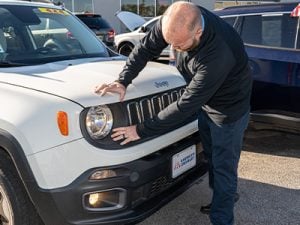Editor’s Note: This blog was initially published in October 2019 and has been updated for additional clarity with new links to other helpful Car-Mart blogs.

Temperatures are dropping. Days are shorter. Before cold weather sets in, it’s the ideal time to prepare your vehicle for winter.
Extreme heat in the summer is hard on a vehicle. Likewise, extreme cold is also hard on a vehicle. So, you must prepare for both weather conditions.
7 tips for preparing your vehicle for winter
Ensure your vehicle is ready for cold weather with this 7-step checklist. Each step is crucial to preventative maintenance.
1. Check the coolant in your vehicle
To prevent fluid from freezing in your radiator. Anti-freeze lowers the freezing point and protects your engine. Checking the anti-freeze is one of the first things to check. It’s not an expensive thing to do. Plus, it’s crucial to the overall life of the engine.
2. Test the battery

Cold temperatures make it harder for an engine to work properly. For peace of mind, check your battery before the cold weather arrives and replace it if necessary. If you don’t have a solid battery, it won’t want to start your vehicle when the temperature drops below 30 degrees.
When checking your car battery, be sure to look for signs of corrosion and loose connections. Also, check the date on the battery sticker. If you’re unsure, take your car to an auto parts store and have them check the battery for you.
Check out our blog, How to Keep Your Car Battery Running Longer.
3. Check the air pressure on your tires
Changing temperatures can lead to uneven tire pressure, impacting overall wear and tear on your tires and your overall safety. Weather change brings differences in tire volume which lowers your tire pressure. During the heat of the summer, as the air gets warm, your tires will expand, and you’ll have good pressure. As the temperature drops, you won’t have good pressure.
Learn more about tires in our blog, The Importance of Tire Rotation.
4. Inspect belts and hoses
Colder temperatures can split hoses and break belts, so replace them if necessary. You want to go into winter knowing you won’t blow a hose or belt.
5. Ensure your windshield wipers are fully functional with ample washer fluid
Maximum visibility is key in inclement weather so make sure you have good, effective wiper blades and adequate all-season washer fluid.
Check out our blog, The Importance of Wiper Blades
6. Check the heater and defroster
This tip is often overlooked. On that cold morning when there is frost on the window, you need heat on the window, so ensure the fans are working on all settings.
7. Check the condition of the windshield, lights, and blinkers

Make sure you can see and be seen. Ensure your windshield, lights, and blinkers are clean and not foggy. Since you’ll be driving more in the dark, you’ll want your windshield to be clear, your lights to not fog over, and your blinkers to be seen by other drivers.
These seven tips will ensure you are ready for winter and give you peace of mind about your vehicle. Including a roadside emergency car care kit in your vehicle is also recommended. Read our emergency kit blog for what to include in your kit.
Finally, check our blog articles on preventive maintenance tips for your vehicle:
- 8 things to know about oil changes
- When to check your brakes
- Washing your car is preventative maintenance
Has your vehicle reached the end of its life expectancy, is it time for a new one? Let us put you in an affordable, quality, used vehicle today. Check out our inventory at one of our locations.



